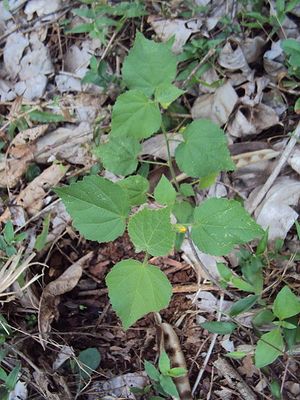Note: This is a project under development. The articles on this wiki are just being initiated and broadly incomplete. You can Help creating new pages.
Sida cordifolia - Bala
Bala or Sida cordifolia (ilima, flannel weed, bala, country mallow or heart-leaf sida) is a perennial shrub of the mallow family Malvaceae native to India. Sida cordifolia or Bala is a plant. The seeds and root are used to make medicine. Sida cordifolia contains ephedrine, which is an amphetamine-like stimulant that can cause harmful side effects. ... Some people use Sida cordifolia as a stimulant, painkiller, and tonic; and to increase urine production and raise sexual arousal.
Contents
[hide]Uses
Bleeding piles, Diarrhea, Fever, Gonorrhea, Aphrodisiac, wounds, Ophthalmia, Painful urination, Paralysis, headache, loss of voice[1]
Parts Used
Chemical Composition
The following alkaloids were reported from S. cordifolia growing in India and β-phenethylamine, ephedrine, pseudo-ephedrine, S-(+)-Nb-methyltryptophan methyl ester, hypaphorine, vasicinone, vasicinol, choline, and betaine.
Common names
| Language | Common name |
|---|---|
| Kannada | Hethutti, Bili kurunthotti |
| Hindi | Bariar, Kungyi Khareti, Kharenti |
| Malayalam | Vellooram, Velluram |
| Tamil | Mayir-manikham |
| Telugu | chirubenda |
| Marathi | NA |
| Gujarathi | NA |
| Punjabi | NA |
| Kashmiri | NA |
| Sanskrit | Bala, Batyalaka |
| English | Country mallow |
Habit
Identification
Leaf
| Kind | Shape | Feature |
|---|---|---|
| alternate | stipulate | The leaves are alternate, stipulate, paripinnate compound, very numerous, closely placed, rachis 8.8-12.5 cm long, narrowly furrowed, slender, pubescent, with an erect linear gland between the leaflets of each pair, leaflets 16-24, very shortly stalked 2-2.5 cm long 1-1.3 cm broad, slightly overlapping, oval oblong, obtuse, at both the ends |
.[2]
Flower
| Type | Size | Color and composition | Stamen | More information |
|---|---|---|---|---|
| bisexual | 2.5 cm long | bright yellow | 5-20 | The racemes are few-flowered, short, erect, crowded in axils of upper leaves so as to form a large terminal inflorescence stamens barren; the ovary is superior, unilocular, with marginal ovules. |
Fruit
| Type | Size | Mass | Appearance | Seeds | More information |
|---|---|---|---|---|---|
| short legume | 7.5–11 cm long, 1.5 cm broad | clearly grooved lengthwise, Lowest hooked hairs aligned towards crown | oblong, obtuse, tipped with long style base, flat, thin, papery, undulately crimpled, pilose, pale brown. | 12-20 seeds | {{{6}}} |
Other features
List of Ayurvedic medicine in which the herb is used
- Vishatinduka Taila as root juice extract
Where to get the saplings
Mode of Propagation
How to plant/cultivate
Plants reach about 3 m height with 3.5 cm stem diameter in 2 years, in 4 years about 5 m height and 7 cm stem diameter. Flowering and fruiting is almost throughout the year, but in India there are usually two main flowering periods, one in the early monsoon and another in the late monsoon.[3]
Commonly seen growing in areas
Tropical, Subtropical plains, Sandy soil.
Photo Gallery
References
Cite error: <ref> tag with name "chemical composition" defined in <references> is not used in prior text.
External Links
- Pages with reference errors
- Pages that are stubs
- Ayurvedic Herbs known to be helpful to treat Bleeding piles
- Ayurvedic Herbs known to be helpful to treat Diarrhea
- Ayurvedic Herbs known to be helpful to treat Fever
- Ayurvedic Herbs known to be helpful to treat Gonorrhea
- Ayurvedic Herbs known to be helpful to treat Aphrodisiac
- Ayurvedic Herbs known to be helpful to treat wounds
- Ayurvedic Herbs known to be helpful to treat Ophthalmia
- Ayurvedic Herbs known to be helpful to treat Painful urination
- Ayurvedic Herbs known to be helpful to treat Paralysis
- Ayurvedic Herbs known to be helpful to treat headache
- Ayurvedic Herbs known to be helpful to treat loss of voice
- Herbs with Root used in medicine
- Herbs with seed used in medicine
- Herbs with Leaves used in medicine
- Herbs with common name in Kannada
- Herbs with common name in Hindi
- Herbs with common name in Malayalam
- Herbs with common name in Tamil
- Herbs with common name in Telugu
- Herbs with common name in Sanskrit
- Herbs with common name in English
- Habit - perennial shrub
- Index of Plants which can be propagated by Seeds
- Index of Plants which can be propagated by Cuttings
- Herbs that are commonly seen in the region of Tropical
- Herbs that are commonly seen in the region of Subtropical plains
- Herbs that are commonly seen in the region of Sandy soil
- Herbs



